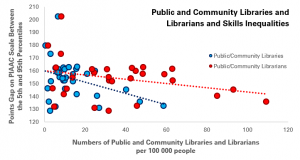So far, our sub-series of Library Stat of the Week posts focused on equality has looked only at income inequality (see #16, #17 and #18).
Yet income is often an indicator, rather than a cause, of inequalities in society, even if it can also reinforce them. Therefore, some people may have low revenues while others have high ones for a number of reasons – health, unemployment, a lack of entrepreneurship opportunities.
A key driver of course is education and skills – human capital. These affect the ability of individuals to take up quality jobs, or to start their own businesses, as well as to benefit fully from the information around them.
At a societal level, skills increase the productive potential of economies, while also contributing to civic engagement and participation.
Inequalities in skills – as well as larger numbers of people with lower levels of skills – can therefore lead not only to inequalities in employment and earnings, but also differing levels of involvement in civic life.
While schools of course have a major impact on levels of literacy among children, the role of libraries – in particular for literacy – is arguably stronger among adults.
Both through providing continuing access to books in order to maintain levels of literacy, and focused learning opportunities, libraries are major players in lifelong learning, in particular for those who may not have access to training through their employment – or the resources to pay for continuing education.
Therefore, for our 19th Library Stat of the Week, we wanted to look at the relationship between the measures of adult skills created through the Organisation for Economic Cooperation and Development’s (OECD) Programme for the International Assessment of Adult Competences (PIAAC), and data from IFLA’s Library Map of the World on numbers of public and community libraries and librarians per 100 000 people.
In doing this, we focused in particular on figures on literacy inequality (the points gap between the 5th and 95th percentiles – i.e. between the person with the 5th from lowest and the 5th from highest skills in a representative sample of 100 people from the group), and the share of the population scoring below Level 1 on the PIAAC scale (i.e. with very low skills).

The first comparison looks at points gaps between the 5th and 95th percentiles. With each dot representing a country for which both PIAAC and Library Map of the World data is available, a higher figure for the points gap indicates greater inequality in levels between the most and least literate.
The comparison here indicates that that there is, a broad correlation in particular between numbers of public libraries and adult literacy inequality, with more libraries tending to mean less inequality.
While there are some countries with low inequality and low numbers of libraries, there are none with lots of libraries and high inequality. The correlation is, however, weaker between numbers of librarians and literacy inequalities.
Secondly, we can look at the shares of low skilled adults in different countries and numbers.

This graph tells a slightly different story. Here, it is the number of librarians that sees the strongest correlations, with more public and community librarians tending to be associated with fewer adults with particularly low literacy. Meanwhile, the relationship is weaker between numbers of public and community libraries, and numbers of low-literate adults.
Once again, there are outliers, with some countries managing low shares of low-skilled adults without higher numbers of librarians, but no country with higher numbers of librarians or libraries also had high shares of less literate adults.
As ever, correlation is not causality, and societies that invest more in ensuring that everyone has access to skills may well also be more likely to invest in libraries and library staff.
Nonetheless, the data would fit with the evidence from the ground that libraries provide a means for people of all ages to maintain their literacy skills, and that library workers, through their understanding of community needs, can help those most in need of support.
Find out more on the Library Map of the World, where you can download key library data in order to carry out your own analysis! See our other Library Stats of the Week! We are happy to share the data that supported this analysis on request.